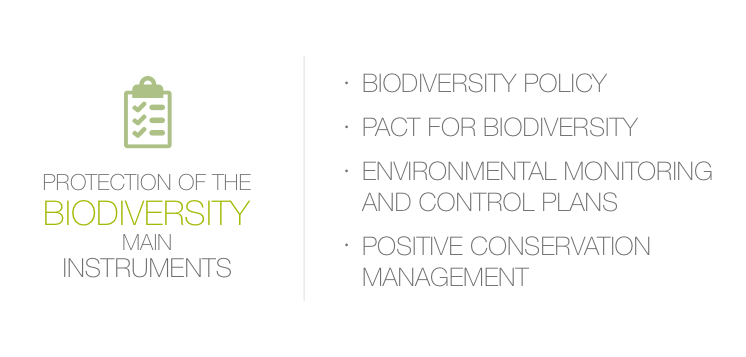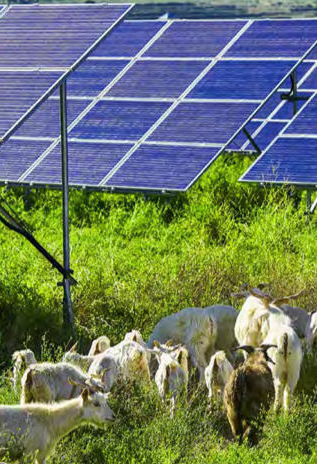Management focus
Four priority lines of action
Climate action Nature Biodiversity
The Earths natural assets are not only essential for the development of biological diversity, but are also fundamental for the economic and social progress of humanity. For this reason, there is an inevitable direct and indirect interaction between the Group's activities and biodiversity.

Generation, distribution and marketing activities produce, throughout their life cycle, interactions with different ecosystems, landscapes and species. Our biodiversity policy, approved by the Board of Directors, places biodiversity and ecosystems at the forefront of our business strategy through four defined priority lines of action:
- Protect biodiversity by applying the mitigation hierarchy throughout the life cycle of the facilities and to make sustainable use of natural capital by adopting a conservation approach, using best practices throughout the life cycle in the management of such facilities and promoting actions for the regeneration and conservation of natural heritage.
- Identify, quantify and assess the impacts and dependencies of the Group's activities on natural capital with a focus on biodiversity throughout the life cycle of the facilities by promoting research and improving knowledge of the ecosystems in the areas where it operates.
- Collaborating with stakeholders taking into account their biodiversity needs and expectations so as to involve them in action plans and gain insight from research projects.
- Acting on our commitment to raise awareness on biodiversity and highlight its significance, informing everyone inside and outside the company of the impact our activities cause and the actions we take to preserve biodiversity.
These lines of activity are managed through various means:
- The Biodiversity Policy, which spells out the company's positioning and its commitment to take biodiversity into account its decision-making processes, and which describes the basic principles of action, such as the application of the mitigation hierarchy, integration into environmental management systems, training, collaboration and information.
- The Biodiversity Pact, of which Iberdrola has been a member since 2013 and which is promoted by the Biodiversity Foundation, part of the Spanish Ministry of Agriculture, Food and the Environment, is intended to show our commitment to the conservation of the environment and the sustainable use of biodiversity.
- The Iberdrola Group Environmental management system common to all organizations within the Iberdrola Group and integrates the Sustainable Development Goals into its environmental directives. The biodiversity and environmental commitments acquired are thus transposed into Group organisations' environmental management systems, most of them certified (EMAS or ISO 14001), which come under the group's Global management system. In these management systems, Group organisations define their continuous improvement objectives in relation to biodiversity, which materialise in environmental monitoring and control programmes and concrete actions aligned with Action Plan principles.
- Environmental impact studies and monitoring plan. Before any construction, using mechanisms for the analysis and prevention of impacts that take into account several alternatives and establish corrective measures to prevent, mitigate or compensate any possible damage, monitored through monitoring plan and management systems.
- Biodiversity action plan, focusing on the protection of species and habitats through the application of positive conservation management and research of sites and surroundings. These actions, both regulatory and voluntary, aim to produce a net positive balance in relation to the environment.
- The Corporate Environmental Footprint (CEF), which provides information on the Group's impact on biodiversity from a life-cycle perspective. The CEF encompasses all our businesses and allows us to know the effects of each technology on biodiversity. Combined with the methodology for the assessment of ecosystem services (REIS Project, USAL), it allows us to determine goals for improvement:
- Direct effects on biodiversity: plans for the protection of wildlife (Eurasian eagle-owl, Bonelli's eagle, Cantabrian capercaillie, etc.) and of flora (Mediterranean forests, indigenous species, etc.), and the management of specific habitats (wetlands, etc.).
- Indirect effects on ecosystems: management plans for the water environment (effluent control, preventive measures for spills and discharges), the soil (preventive measures for spills) and specific biodiversity management plans.
- Policy on relationships with Stakeholders, since approved by the Board of Directors on 17 February 2015 External link, opens in new window..

Biodiversity protection
How do we protect and preserve biodiversity on some of our more flagship projects?

Corporate Environmental Footprint (CEF)
We publish an annual summary of the Group's environmental performance.




